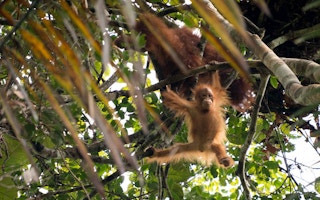A planned highway network in the Malaysian state of Sabah on the island of Borneo threatens the forests protected as part of the Heart of Borneo agreement made with Indonesia and Brunei, a new study has found.
The goal of the agreement was to ensure the survival of continuous rainforest in central Borneo that houses wildlife populations, helps to mitigate climate change and fosters the island’s unique biology. But the construction and expansion of roads for the Pan Borneo Highway project could carve up the core of this ecosystem, the researchers who wrote the paper say.
“We just know that these [roads] are going to have really severe effects in some of the last, sizable intact tracts of forest in Borneo and in the world,” William Laurance, a tropical ecologist at James Cook University in Australia and the study’s senior author, said in an interview.
The team’s research, published Sept. 18 in the journal PLOS ONE, plotted out the series of new and expanded roadway construction that’s part of the multi-year Pan Borneo Highway project in Sabah. The researchers compared these plans with the locations of intact forests, parks and reserves in the state, and then they modeled the repercussions on surrounding forests.
“Some of the planned highways are relatively benign, but several are flat-out dangerous,” Sean Sloan, the study’s lead author and an ecologist at James Cook University, said in a statement. “The worst roads, in southern Sabah, would chop up and isolate Sabah’s forests from the rest of those in Borneo.”
In particular, a planned stretch between the towns of Kalabakan and Sapulut near Sabah’s southern border with the Indonesian province of North Kalimantan would slice through the Heart of Borneo conservation area.
The cross-border initiative covers some 220,000 square kilometers (85,000 square miles), and since its inception in 2007, Sabah has more than doubled the area of forests protected under state law. But to succeed, the Heart of Borneo requires transnational cooperation, as it spans parts the three countries with territory on the island.
“
We just know that these [roads] are going to have really severe effects in some of the last, sizable intact tracts of forest in Borneo and in the world.
William Laurance, tropical ecologist, James Cook University
Constructing parts of the highway in sensitive areas of Sabah is tantamount to “plunging a dagger into the heart of Borneo’s endangered forests and wildlife,” Laurance said. In the researchers’ view, plans for the Pan Borneo Highway project should incorporate not just the impacts on parts of Sabah, but on the broader — and still relatively intact — ecosystem that the Heart of Borneo was designed to protect.
The incursion of roads into previously untouched or lightly used forest often leads to a rise in deforestation, hunting, illegal mining and other damaging effects to the surrounding ecosystem.
Borneo is home to some of the oldest rainforests on the planet, which have existed for 130 million years. In that time, the island’s unique species have flourished, evolving alongside a unique set of ecological dynamics.
Laurance pointed to the mast fruiting of the towering dipterocarp trees that anchor the island’s forest ecosystems. Every few years, bunches of these trees fruit in a synchronized pulse, resulting in a cornucopia of food for bearded pigs (Sus barbatus), sun bears (Helarctos malayanus), orangutans (Pongo pygmaeus) and a host of other hungry species. Some animals track these migrations across routes that extend for hundreds of kilometers.
“That is a really important part of the Borneo story,” Laurance told Mongabay. “The migration was absolutely critical to Borneo.”
But the construction and expansion of roads throw up potential hurdles to these migrations, as well as the movement of animals like Borneo’s dwarf variety of elephant, that are integral to the biology of the island, he said.
Planners have proposed stitching together patches of rehabilitated forest to serve as corridors and building underpasses that would allow animals to move from one side of the road to another without endangering themselves or motorists. But Laurance and his colleagues question how effective they’ll be in maintaining meaningful connections between populations.
“These proposed mitigation measures for these highways are very likely to be grossly inadequate,” Laurance said.
Forest rehabilitation and underpass construction are expensive, the researchers note. They calculated that a set of underpasses at eight proposed sites along the highway’s routes could cost $38 million or more, a figure that’s larger than the state’s annual budget for the Heart of Borneo initiative.
The team’s analysis also suggests that Sabah’s plans miss crucial corridors that would help secure the links that are vitally important to the health of wildlife populations — if the animals choose to go along with these remedies, that is.
“We also know that wildlife are often doggedly uncooperative in using these things,” Laurance said.
Whether these strategies are successful also hinges upon the quality of the habitat that the corridors or underpasses stitch together.
“When you build a new road you typically get a lot of forest destruction and fires, along with poaching, and that means vulnerable wildlife will largely avoid the area,” Mohammed Alamgir, an ecologist at James Cook and one of the paper’s authors, said in the statement. “Relying on underpasses to reduce road impacts is like trying to treat cancer with a band-aid.”
The researchers suggest rethinking or canceling the parts of the highway with the most potential for causing damage, especially the Sapulut-Kalabakan section. If the Pan Borneo Highway goes forward there as planned, it’s likely to “cut off the head of the Heart of Borneo,” Laurance said, irreversibly altering one of the world’s critical repositories of biodiversity.
“This a very obvious and dramatic existential threat to some of the last surviving intact forests” in Borneo, he said.
This story was published with permission from Mongabay.com.








